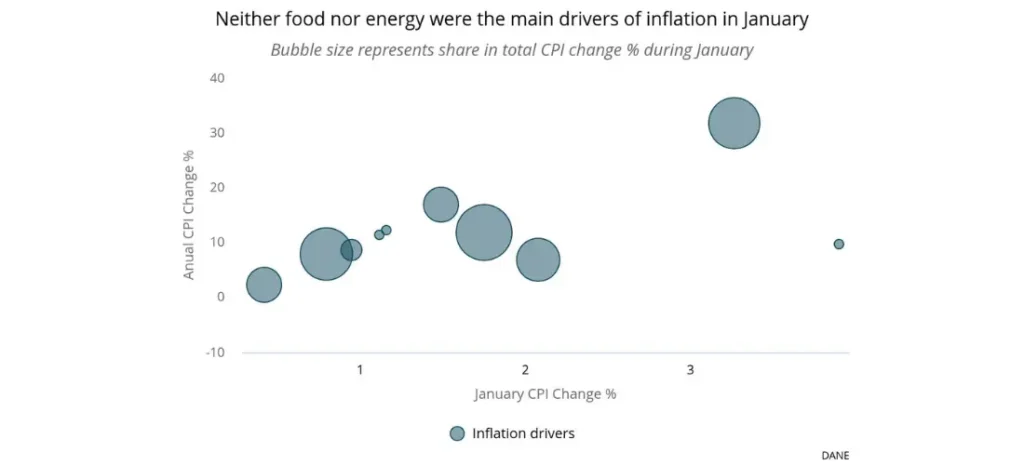
Food and energy prices could be among the most affected by volatile weather
Multinational corporations operating in the food industry can anticipate a slight reduction in their supply of certain local crops, along with moderate price increases for these agricultural goods. Manufacturing and service businesses without energy coverage contracts should anticipate rising electricity costs.
Overview
The El Niño weather phenomenon is looming over Colombia, induced by the elevation of sea surface temperatures in the central and eastern equatorial Pacific Ocean. This disrupts conventional weather patterns, accelerating global climatic shifts, including deviations in precipitation and extremes of temperature.
Volatile weather in January affected over 23,000 hectares of land destined for agriculture and another 68,000 hectares for cattle farming. While the primary impacts have occurred due to drought, approximately 9,000 hectares have been affected by frost in Andean regions like Boyaca or Cundinamarca. Climate disruptions have impacted the agricultural production of certain regions, causing price increases for a limited number of crops.
Furthermore, El Niño has also intensified pressure on Colombia’s electricity prices. Up to 80% of Colombia’s power generation comes from hydropower sources. Less frequent precipitations and increasing evaporation rates from water reservoirs due to heightened temperatures are already impacting electricity’s spot price.
The impacts of the El Niño phenomenon on water resources and crops have compelled the government to declare a national climate emergency. Several measures to control wildfires, address water scarcity, and mitigate price inflation have been implemented.
- According to the minister of agriculture, while some local prices were impacted by El Niño, overall food prices increased (0.42% in January) mainly due to seasonal factors.
- Despite an increase in electricity spot prices during January, current levels remain far below the scarcity price. Surpassing this threshold would trigger an emergency situation in Colombia’s electrical system.
- The government, through the Energy and Gas Regulation Commission, has announced a new rule that will regulate energy spot prices. If approved, this cap could be inconvenient due to the erosion of price signaling in the electrical system, impairing the efficient use of water resources.
- More than 230 municipalities faced water scarcity during January.
- From November to January, a total of 372 forest fires were recorded.
- Demand for certain consumer goods, such as ice cream and air conditioners, has been positively impacted by El Niño.
- Colombia’s central bank is closely monitoring El Niño. The decision to hold or cut interest rates will be partially influenced by how this climate phenomenon impacts consumer prices.
Our View
It is likely that a transition from El Niño to more neutral weather conditions will occur by April. During this time, we expect Colombia’s electricity system to be able to cover any water deficit produced by the El Niño phenomenon either through increased reliance on natural gas and fuel as power sources or through the use of future contracts. It is worth mentioning that up to 80% of electricity is traded through future contracts, so momentary reductions in water resources or jumps in spot prices do not necessarily affect overall consumer bills.
Our base-case scenario assumes that water reservoirs will remain above emergency levels, keeping electricity spot prices in check. Nevertheless, substantial reductions in water reservoirs could significantly increase electricity prices.
Government attempts to regulate spot prices could create negative incentives through water management. A price cap may incentivize some generators to increase prices to cover potential losses when real prices go above the government’s COP 500 cap. This initiative has not been ratified yet.
The impact of El Niño on price increases of agricultural goods remains limited; however, persistent volatile weather conditions could restrict the supply of high-demand crops such as rice, ripe bananas, sugar cane, cassavas, and potatoes, causing further price rises.
According to the National Weather Service, following El Niño, there is a 55% chance of the La Niña phenomenon developing from June to August. In this scenario, the government would need to prepare for increased precipitation, which has the potential to negatively impact some crop production. However, it would significantly reduce electricity spot prices.
At FrontierView, our mission is to help our clients grow and win in their most important markets. We are excited to share that FiscalNote, a leading technology provider of global policy and market intelligence has acquired FrontierView. We will continue to cover issues and topics driving growth in your business, while fully leveraging FiscalNote’s portfolio within the global risk, ESG, and geopolitical advisory product suite.
Subscribe to our weekly newsletter The Lens published by our Global Economics and Scenarios team which highlights high-impact developments and trends for business professionals. For full access to our offerings, start your free trial today and download our complimentary mobile app, available on iOS and Android.
